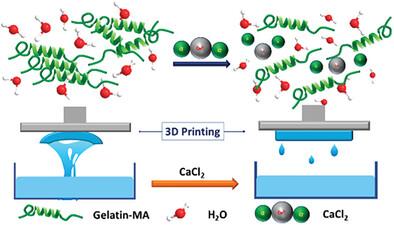Hofmeister Ions‐Induced Thinning of Gelatin to Enhance 3D Printing Precision
引用次数: 0
Abstract
Hydrogel 3D printing holds immense potential in fields like personalized medicine, regenerative therapies, and organ creation, offering biocompatible structures similar to the extracellular matrix. Gelatin‐Methacryloyl (GelMA) emerges as a promising candidate, while its high viscosity poses a significant challenge, especially in vat photopolymerization‐based 3D printing. Here, a new approach is presented by using Hofmeister ionic effect to substantially reduce the viscosity of high‐content (up to 60%) Gelatin bioink at room temperature with enhanced mechanical performance of the printed structures. The thinning effect induced by chaotropic Hofmeister ions is investigated through complex viscosity analysis, optical rotation measurements, and sol–gel conversion studies. The thinning effect induced by chaotropic ions enables precise 3D printing of Gelatin hydrogel, achieving accuracy comparable to prints made with polymers. Furthermore, after polymerization, the cations of the chaotropic salt change their role to cross‐linkers, leading to stronger scaffolds that exhibit biocompatibility with robust cell attachment, proliferation, and suitability for cell growth. The combination facilitates the creation of customizable structures and high printing accuracy will promote the wide application of Gelatin in the development of patient‐specific implants, drug delivery systems, and tissue scaffolds, further improving medical treatment efficacy and personalized healthcare.

霍夫迈斯特离子诱导明胶稀化,提高三维打印精度
水凝胶三维打印在个性化医疗、再生疗法和器官创建等领域具有巨大潜力,可提供与细胞外基质类似的生物相容性结构。明胶-甲基丙烯酰(GelMA)是一种很有前景的候选材料,但它的高粘度带来了巨大的挑战,尤其是在基于大桶光聚合的三维打印中。本文介绍了一种新方法,即利用霍夫迈斯特离子效应在室温下大幅降低高含量(高达 60%)明胶生物墨水的粘度,同时提高打印结构的机械性能。通过复杂粘度分析、光学旋转测量和溶胶-凝胶转换研究,研究了各向同性霍夫迈斯特离子诱导的稀化效应。各向混沌离子诱导的稀化效应可实现明胶水凝胶的精确三维打印,打印精度可与聚合物媲美。此外,在聚合之后,混沌盐中的阳离子会转变为交联剂,从而形成更坚固的支架,这种支架具有生物相容性,能促进细胞附着、增殖并适合细胞生长。这种组合有助于创建可定制的结构,而且打印精度高,将促进明胶在开发患者专用植入物、给药系统和组织支架方面的广泛应用,进一步提高医疗效果和个性化医疗保健水平。
本文章由计算机程序翻译,如有差异,请以英文原文为准。
求助全文
约1分钟内获得全文
求助全文

 求助内容:
求助内容: 应助结果提醒方式:
应助结果提醒方式:


